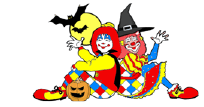
These improv exercises are perfect for the clown educator. Improv games and exercises can be used for all ages, and they teach valuable skills for all forms of clowning.
"Clowns believe they can do anything and their desire and curiosity to try new things is limitless." Thus, it is important to start with these exercises to challenge ourselves and find within us the inner critic.
First Exercise:
Gather the students together and tell them to find their own space within a room. Get them to imagine an object that they could get stuck in. Then ask them questions, like: What does it feel like? What color is it? Now, after the students got a clear idea of the object they're now stuck inside of, get them to imagine how they can escape this object! An example would be: being stuck in a pumpkin shell and scooping one’s self out with a super large, slippery pumpkin seed. Be sure to have the students act these out physically and verbally. When they escape make sure they celebrate. After the exercise, get them to evaluate themselves and critic their choices. Did they work at their maximum level, or could they have done more?
Have them repeat the exercise, but this time get them to challenge their comfort zones! Invite them to be louder and more physical. Give 110%! Basically, this is teaching the skill of what I like to call “Drop kicking your critic.” Being above and beyond all expectations and just “owning it.”
Second Exercise:
The second exercise can be used after the first exercise or technically at any time you see fit. It’s human nature to punish ourselves when we make mistakes. We fear failure, but clowns embrace failure and let the problem become the solution.
To teach this skill, students will begin by throwing a large (real) ball in a circle. The first couple of throws they will imagine that the ball is just a normal ball. The next couple of throws they will imagine that the ball is now made of glass. The final round of throws they will imagine the ball is a puppy. If at any time the ball falls the whole group takes a moment and says (awe) and then the student who dropped the ball, instead of punishing themselves, they will step in the middle of the circle and with big outstretched arms they'll loudly exclaim, “TA-DA!”. Then they'll go back into the circle and the game continues. This can help not only teach the clown skill of owning your mistakes and turn them into solutions, but it can also teach self esteem.
Have fun with these exercises. Use them, adapt them, make them your own when you teach clowning! Or, use them the next time you runout of things to do at a birthday gig, or anywhere else. Improv exercises and games can really help make that connection between student and teacher, and can make essential clown skills easy to learn and understand.
Along with teaching kids of all ages improv games and exercises for learning valuable clown skills, you'll also need to be sure you keep their attention. The best way to educate someone is to entertain them at the same time. Need help with that? Here is a link to a great book to start you off.
